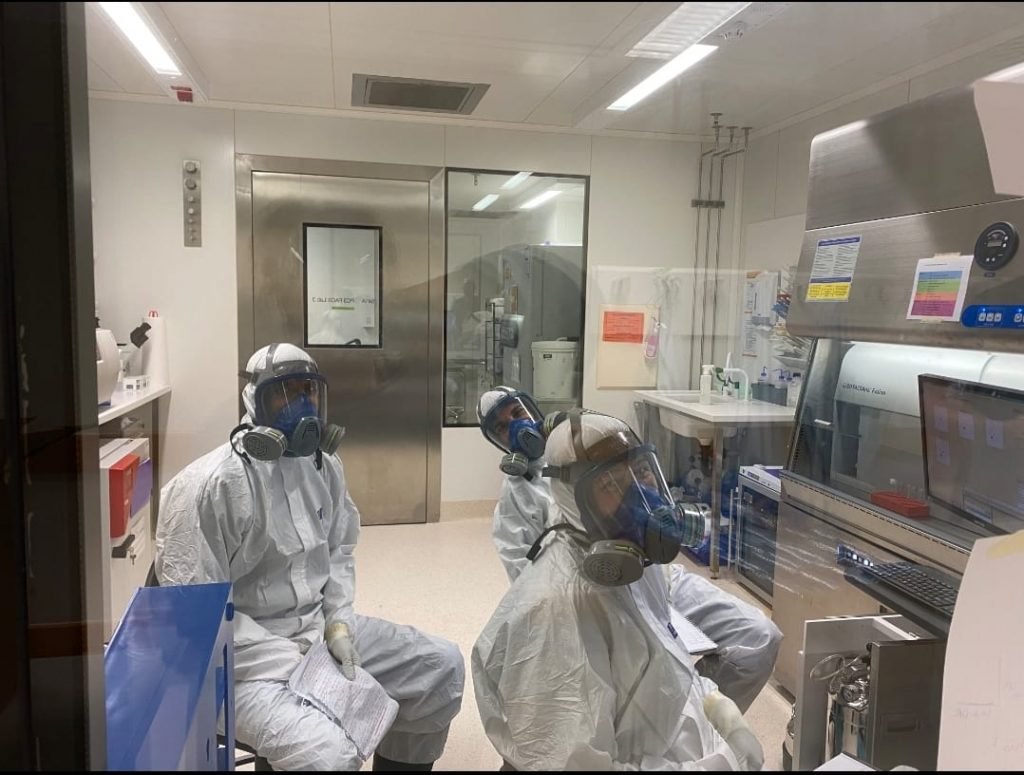Biological safety laboratories are designed to handle pathogens and other potentially hazardous materials safely and with minimal risk. It also describes protective measures to be conducted by laboratory workers both within and outside the laboratory. Biosafety levels of lab distinguishes the level of safety and pathogens handled.
- Following the series of biosafety levels, it reduces a laboratorian’s risk of exposure to potential pathogens and limits the contamination of the working environment.
- The outline of the biosafety level is defined in Biosafety in Biomedical Laboratories (BMBL) about the specific practices with safety and facility requirements. The biosafety and personal equipment, laboratory designs and practices, availability of preventive medical treatments are determined through biological risk assessments which are evaluated by the study of infectious agents or toxins with its transmission and ability to cause infection.
- Different countries have defined biosafety levels in their own way. In the USA, the level of containment ranges from BSL-1 to BSL-4 by the Centers for Disease Control and Prevention (CDC). Similarly, in Europe countries, the biosafety levels are defined in a ‘directive’ and in Canada, as ‘containment levels’.
- Additional specific rules and designations are also determined in animal research (ABSL), agricultural research (BSL-Ag), and other types as they include larger animals, plants, and insects so they require their own specific rules and regulations.
- The biosafety level ranks from BSL-1 to BSL-4 according to the level of risk where BSL-1 with low risk and the following are in increasing order.

Explanation of each biosafety level is given below:
Biosafety Level 1 (BSL-1)
- Biosafety level-1 laboratories are designed to study the microorganisms that are non-pathogenic to humans or animals and cause a minimal potential hazard to laboratory workers and the environment.
- Due to minimal risk, precautions are also limited compared to other levels.
- Level 1 laboratory consists of table and benches where research work takes place without the use of special contaminant equipment.
- Basic safety procedures like Standard Microbiological Practices are followed which are simple and require no special designs and types of equipment.
- Common safety types of equipment like lab coats or gowns, surgical gloves and masks, and eye-protective gears (optional) are used.
- Hand washing is a must before and after the use of the laboratory. However, eating, drinking, and smoking are strictly prohibited inside the laboratory areas.
- Daily decontamination of work surfaces and used materials with a chemical such as ethanol or bleach or isopropanol and use of an autoclave is done to lower the contamination.
- The working lab space should have separate door from the other facilities.
- Non-pathogenic strains of E. coli, Staphylococcus and Bacillus are appropriate to use that do not cause disease to human.
- BSL-1 laboratories are generally used in high schools and colleges because of its safety and very low risk of contamination.
Biosafety Level 2 (BSL-2)

- Biosafety level-2 laboratories are designed to work with the pathogenic or infectious organisms that are associated with human diseases.
- They maintain the same standard as BSL-1 but include more additional precautions due to its potential risk to lab personnel as well as the environment.
- Trained personnel is required in the handling of pathogenic agents and require extreme precaution while using sharp contaminated types of equipment to prevent cuts and exposure to skin.
- Use of appropriate PPE, lab gowns, gloves, face shield masks, and eye protector must be used.
- Experiments are performed within a biological safety cabinet (BSC).
- The laboratory must have self-closing and lockable doors and only a limited number of workers should get access to the working place.
- Handwashing sink and eyewash station should be readily available in case of emergency.
- Hepatitis A, B, and C viruses, HIV viruses, pathogenic strains of E. coli, Staphylococcus, Salmonella and Plasmodium with a moderate potential causing organisms are suitable in BSL-2.
Biosafety level 3 (BSL-3)

- Biosafety level 3 laboratories are designed to work with the microbes that can cause potentially serious infection through the route of respiratory transmission.
- Precautions used in BSL-1 and BSL-2 are well maintained with additional measures like medical surveillance is provided to all laboratory personnel with immunization where relevant to reduce the risk.
- Standard personal protective equipment such as respirators and solid front protective clothing must be worn and discarded after each use.
- All experiments must be performed by professional research workers under the Biosafety cabinet.
- The window must be sealed and the use of a ventilation system with sustained directional airflow to draw air in must be placed.
- The entrance of the BSL-3 laboratories must be separate from the one building with limited access and self-closing doors.
- Microbes that can cause infection through inhalations are used at this level. These include Mycobacterium tuberculosis, Yellow fever, West Nile virus, SARS-CoV 1, and 2, Rickettsia rickettsii.
Biosafety Level 4 (BSL-4)
- Biosafety level-4 laboratories are the most advanced with the highest level of precautions and are designed to study microorganisms with a very high risk of infections and cause severe to life-threatening cases in humans without any treatment or vaccines.
- The BSL-4 laboratories should maintain all the rules of BSL-3 with additional safety measures.
- Generally, there are two types of BSL-4 laboratories:
- Cabinet laboratory: All experiments are performed under the Class III Biosafety cabinet. Similarly, laboratory space is also designed in such a way to prevent contamination.
- Suit laboratory: Full body air supplied suits are required before entering the working area and showering and following decontaminating procedures before existing.
- The equipment used must be blunt in order to reduce the risk of damaging gloves and safety clothes.
- The lab should be located in an extremely isolated place with vacuum lines that filters and purifies air and a decontaminating system.
- Ebola virus, Lassa virus, Marburg virus are studied in BSL-4 laboratories.
References:
- https://www.phe.gov/s3/BioriskManagement/biosafety/Pages/Biosafety-Levels.aspx
- https://www.phe.gov/s3/BioriskManagement/biocontainment/Pages/BSL-Requirements.aspx
- https://thebiologynotes.com/biosafety-levels/
- https://www.germfree.com/articles/biosafety-levels-for-laboratories/
- https://www.cdc.gov/training/quicklearns/biosafety/
- https://consteril.com/biosafety-levels-difference/
- https://en.wikipedia.org/wiki/Biosafety_level#:~:text=A%20biosafety%20level%20(BSL)%2C,4%20(BSL%2D4).